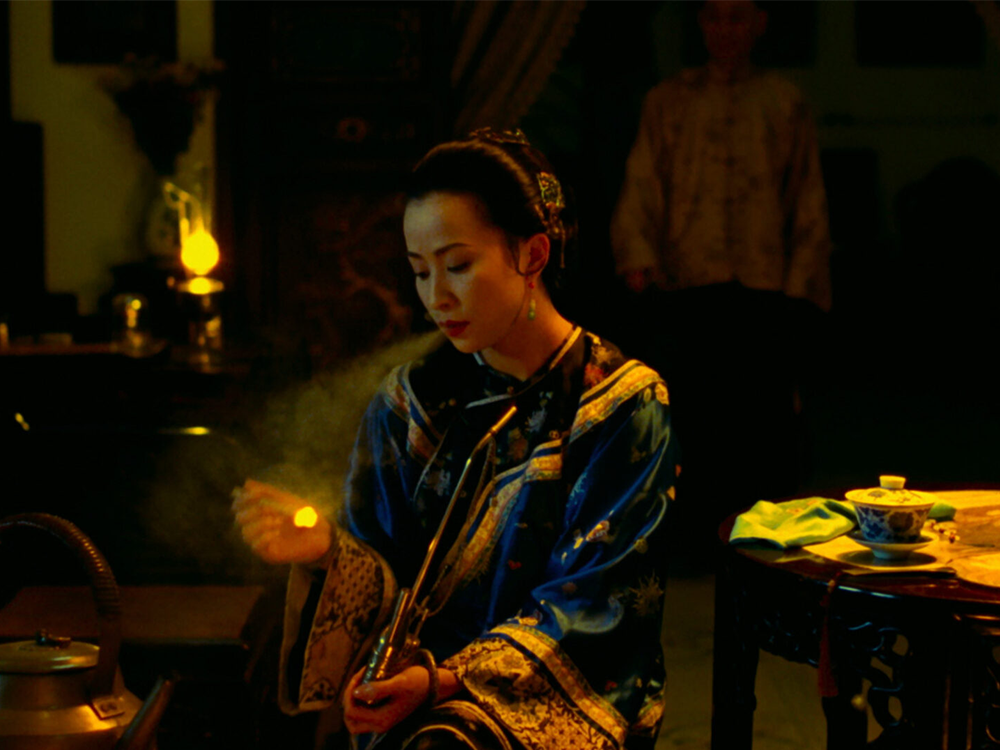
In late-19th-century Shanghai, brothels are known as “flower houses.” A small and confined world unto themselves, the brothels offer an alternate universe for the well-to-do male clientele. But for the women who work within, the brothels are no fantasyland; they either succumb to this reality or fight against destiny.
EN
“Hou Hsiao-hsien’s Hai shang hua (Flowers of Shanghai, 1998) is a film constructed like no other: it doesn’t follow the conventions of gradual and deliberate narrative unfolding; it doesn’t vary sets greatly; it doesn’t distinguish the characters from one another in particularly obvious ways. It is a riddle that almost exclusively employs a third person limited narrative eye and ear through which the audience absorbs story information. The audience is then forced to puzzle over its meaning and implications. Partly because this unusual narrative technique is difficult to decipher, and partly because of the overwhelming richness of the mise en scène, most of the scholarship on Hou’s intriguing and unique presentation of late Qing Dynasty life among the high-class brothels of Shanghai focuses on the visual splendour of the cinematic presentation. Gang Gary Xu goes so far as to assert that the camera takes its position as a sort of “character in the film by participating” in it, especially in the banquet scenes. The camera methodically pans back and forth between speakers and other items of interest, constantly reminding the viewer it is stationed spatially within the scene itself, an unspeaking but present observer that is “animated” but also always “remind[ing] us of its limitations in the field of vision”.”
Christopher Lupke1
“Hou Hsiao-hsien crafts a visually hypnotic and intricately fascinating portrait of love, power, and servitude in The Flowers of Shanghai. By confining the scenes to interior shots of the Shanghai flower houses, Hou portrays the created, artificial world – the unsustainable illusion – of the flower house patrons. In essence, the flower houses are an idealized reflection of the patrons’ own ambivalent feelings between love and passion, obligation and generosity, commitment and fidelity. Inevitably, their hermetic environment of lavished wealth and drug-induced escapism cannot prevent the objects of their affection – the emotionally resilient flower girls – from escaping their tenacious, suffocating grasp.”
Acquarello2
“The subtlest of formalists, Hou Hsiao-Hsien is a director whose considerations of film language are so foundational – placement, movement, duration – as to be imperceptible, and so organic to the larger narrative as to seem nonexistent. Some would experiment with film form by actively pushing limits, stroking furiously at camera, lighting, and editing – the showy, copious manipulation intended as a demonstration of capacity. Hou is no less engaged, but like the best of minimalist painting, sculpture, and music, his choices challenge audiences to consider their relation to the art, to acknowledge their own distance from the object before earning intimacy.”
Eric Hynes3
“Although the life experience depicted in Flowers of Shanghai is indeed very far away from us, ever since we were young, we basically grew up reading novels and literature from that period, which turned out to be very helpful. So there is actually a certain familiarity. I’ve always loved the feeling of those huge extended families depicted in novels like [the early Qing masterpiece] Dream of the Red Chamber [Hong lou meng]. I also was always attracted to those big banquet scenes, even though these may be terribly complicated. The biggest difficulty comes with how you are to recover these elements and capture them. Film isn’t historical in the sense that you can go through and research all the details; that would be impossible. All that we want to do is capture that atmosphere and re-create it in a way that represents our imagination of Flowers of Shanghai, as well as all those other early vernacular novels we are familiar with. This is the most difficult part. So we had to do multiple takes of every shot. It would have been impossible to print anything after the first take because we were allowing the actors to slowly acclimate themselves to the atmosphere and ambience of life in a late Qing brothel.”
Hou Hsiao-Hsien4
- 1Christopher Lupke, “What is Said and Left Unsaid in Hou Shiao-hsien’s Flowers of Shanghai,” Senses of Cinema, March 2012.
- 2Acquarello, “The Flowers of Shanghai, 1998,” Strictly Film School, 2000.
- 3Eric Hynes, “A Time to Live and a Time to Die,” Reverse Shot, August 2008.
- 4Hou, Hsiao-hsien, Tianwen Zhu and Michael Berry, “Words and Images: A Conversation with Hou Hsiao-hsien and Chu T'ien-wen,” positions: east asia cultures critique 11 (2003): 675-716.

